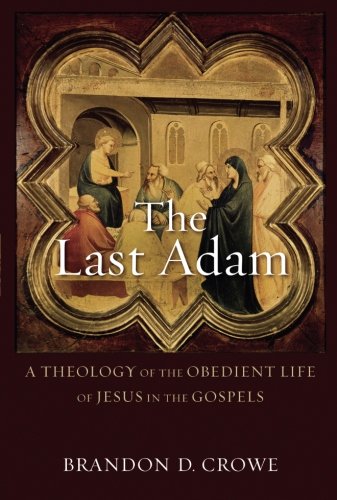Reviewed by Micah McCormick
Brandon Crowe has written a wonderful book—The Last Adam: A Theology of the Obedient Life of Jesus in the Gospels. In this book, Crowe aims to “set forth the soteriological significance of the life of Jesus in the Gospels” (ix). More specifically, he argues that “Jesus is portrayed in the Gospels as the last Adam whose obedience is necessary for salvation” (2). Early on the reader sees a flag planted in the ground—this book will not be merely a historical study, it will not merely present exegetical work in the gospels, and it will not merely tie together larger biblical-theological themes. Rather, this book is a composite work that draws from multiple disciplines within biblical studies and theology. Although this may sound like a lofty goal for one book, it is refreshing to see a work that doesn’t try to reconcile friends.
The book is divided into eight chapters. Chapter one is an introduction that repeats some big questions about the life of Jesus. It also offers a brief historical sketch of Adam-Christ parallels from various figures from the past (so throw historical theology into Crowe’s interdisciplinary mix). The last chapter draws together a synopsis of the book and does not shy away from systematic conclusions—affirming imputation and active obedience, among other doctrines. The heart of the book is spread over chs.2-7. In these chapters, Crowe marshals evidence to paint a gospel portrait of a thorough going second Adam Christology. As the title of the book indicates, the overarching tie is that of obedience, but Crowe also relates Jesus to Adam through his sonship and embodiment of the true Israelite. In addition, the themes of kingdom and salvation contribute regal imagery and covenant hope that is also found in the early pages of Genesis.
Crowe’s book is a great example of a kind of biblical theology that gives attention to narrow exegetical questions (e.g. how should Hosea 6:7 be rendered?), to the main didactic purposes behind units of Scripture (e.g. is Jesus commending a positive example to the lawyer in Luke 10 or showing the lawyer that he can’t fulfill the law?), to broader questions of theological reflection (e.g. if Jesus is a representational figure after the pattern of Adam and Israel, what relevance does that have for his saving work?). In this respect, he follows the footsteps of Murray, Kline, and Beale, all of whom he quotes warmly and approvingly. Crowe draws the life and death of Jesus together as an integral whole, rather than dividing them up and assigning “exemplary” to the one and “redemptive” to the other.
Along the way, Crowe suggests a copious amount of allusions, cross references, and thematic links that contribute to his overall thesis. The Scripture index alone is a valuable resource. Many of these claims are warranted and are repaid by thoughtful reflection. (Although of course with any book wringing out so many echoes, I was still scratching my head about some—e.g. Jesus’s spittle healing anticipating those who spit on him during his death, p.112.) But this point leads to a warning: this book deserves thoughtful reflection. It is both easy to read and challenging to read. It is not an academic book in the sense that it is filled with academic jargon or foreign words or unwieldy footnotes. The English and syntax are clean enough, and in that sense it is easy to read. But it is a very dense book. Crowe often makes a series of thematic link-steps, affirms an overall point, and then moves on, assuming the reader has readily followed all of those steps. One example will suffice: “Jesus’s identity as the Holy One of God deals not simply with ritual or cultic imagery but is at the same time language for moral holiness toward God. The Synoptics teach that the two greatest commandments are to love God and to love one’s neighbor (Matt. 22:37-38 // Mark 12:29-31 // Luke 10:27), the second of which comes from Leviticus 19, where God’s people are called to a holy way of life. Thus, full-hearted obedience to God includes not only cultic practices but also love (= obedience) for God (Deut 6.5) and love for one’s neighbor (Lev 19:18). The holiness of Leviticus, in other words, has in view not only the need for ritual purity but the need for heartfelt devotion to God and love for others, and these were to be manifested in one’s actions. Thus Jesus’s holiness as Son of God entails a moral dimension” (p.113). The Last Adam should be widely recommended, but it shouldn’t be recommended to all.
Amidst all of the excellent discussion of obedience motifs in the life of Christ, I do wish Crowe would have given more attention to the story of Jesus as a young boy in the temple (Luke 2:41-52). Crowe does mention various elements of the story in passing (pp.79, 95, 101, 104, 207), but given the uniqueness of the story (the only biblical record we have of Jesus’s activity from infancy up until his public ministry), the central theme of obedience both to his heavenly father and his earthly parents (2:49, 51), and the larger thematic echoes of Jesus as the consummate child of wisdom (2:47, 52) in light of Adam’s unwise choice and the Bible’s search for a wise man, I think Crowe could have waded deeper into this story in support of his thesis.
But this is a tiny misgiving in light of the wealth of material this book provides. Crowe services New Testament scholars and systematicians alike, and pastors preaching through one of the gospels would do well to keep a copy of The Last Adam on their desk along with their preferred commentary.
Micah McCormick (PhD) is associate pastor at New Hyde Park Baptist Church in New Hyde Park, NY.
